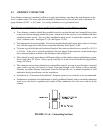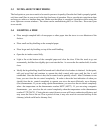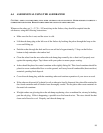35
3.3 NOTES ABOUT FIRST FIRING
The fresh paint on your stove needs to be cured to preserve its quality. Once the fuel load is properly ignited,
only burn small fires in your stove for the first four hours of operation. Never open the air control more than
necessary to achieve a medium burn rate. Make sure that there is enough air circulation while curing the
stove. Open one or more windows. The odours can be smelled during the 3 or 4 first fires. Never start your
stove outside.
3.4 LIGHTING A FIRE
• Place enough crumpled balls of newspaper or other paper into the stove to cover thbottom of the
firebox.
• Place small and dry kindling on the crumpled paper.
• Place larger and dry kindling on top of the small kindling.
• Open the air intake control fully.
• Light a fire at the bottom of the crumpled paper and close the door. If the fire tends to go out
momentarily, hold the door slightly ajar to activate the fire. As soon as the fire catches hold, close the
door.
• Ideally the large kindling should be burned until a thick bed of red embers is obtained. At that point,
add cord wood fuel and continue to operate the draft control wide open until the fire is well
established. Once the firebox is hot, the air control can be partially closed. After 30 minutes to one
hour, you can close the air control completely. In order to have the best indication of when you
should close the air control completely to operate your stove the most efficiently, use a chimney
(flue) thermometer. If you are using a probe thermometer, you can close the air control completely
when the temperature on the thermometer reaches 900
o
F (482
o
C). If you are using a magnetic
thermometer , you can close the air control completely when the temperature on the thermometer
reaches 475
o
F (246
o
C). Closing the air control down too soon will lower combustion efficiency and
may cause the fire to die out. Over a period of time, it may also result in creosote build-up in the
chimney (which could lead a chimney fire).


















